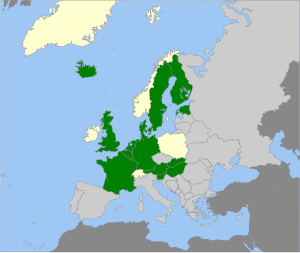Green herring blubber
| Green herring blubber | ||||||||||||
|---|---|---|---|---|---|---|---|---|---|---|---|---|
| Systematics | ||||||||||||
|
||||||||||||
| Scientific name | ||||||||||||
| Russula pseudo-olivascens | ||||||||||||
| Kärcher |
The green or light green herring deafness ( Russula pseudo-olivascens syn. R. elaeodes ) is a fungus from the family of deaf relatives (Russulaceae). It is a herring blubber (subsection Xerampelinae ) with the typical smell of herring brine and mostly green hat colors.
features
Macroscopic features
The hat is olive or yellow-green in color, sometimes it is also brownish or reddish flesh. It has darker tones in the middle and lighter tones on the edge. The cap reaches a diameter between four and eight centimeters. The surface is smooth to wrinkled in the middle and mostly shiny. Half of the hat skin can be peeled off at most. The slats are light ivory in color and are quite crowded.
The stem is white, but turns brownish, but not reddish. It becomes up to three inches long. The flesh is white, but turns brown, is relatively soft and fragile. It tastes mild and smells typical of herring brine. Occasionally the odor is not very pronounced. As with the red herring blubber ( R. xerampelina ), it immediately turns olive green with iron sulfate and red to almost coral red with aniline .
The spore powder is cream-colored to light-colored.
Microscopic features
The spores are almost spherical at 6.5–9 × 6.2–8 micrometers. The surface is coarse-black-prickly and burr to almost reticulate. Cystidia are numerous and spindle-shaped, but are normal.
Species delimitation
The green herring blubber is well characterized by its herring brine smell and green hat colors. Other green deafblings such as the grass-green deafblings ( R. aeruginea ), the green edible deafblings ( R. heterophylla ) or green forms of the female deafblings ( R. cyanoxantha ) lack this characteristic odor.
Ecology and diffusion
The green herring deaf can be found in the deciduous forest under birch , oak , sweet chestnut , red beech and linden on acidic soils. The fruiting bodies appear from August to October.
The fungus is found scattered in Central and Western Europe. It has been found in France, Luxembourg, the Netherlands, Austria, Germany, Hungary, Denmark, Finland, Slovakia and Estonia.
Systematics
Inquiry systematics
The green herring deaf is placed by Bon in the sub-section Xerampelinae , which in turn is part of the Viridantes section. The subsection contains medium-sized to robust pigeons that enter into a symbiosis with various deciduous trees. Their slightly yellowing or browning meat has a mild taste and smells of herring or crab. With iron sulphate, it turns green. At Romagnesi the deaf is in the Viridantinae section .
meaning
The green herring blubber is edible.
literature
- Edmund Michael, Bruno Hennig, Hanns Kreisel: Handbook for mushroom friends. Volume five: Agaric mushrooms - milk lice and deaf lions. 2nd Edition. Fischer, Stuttgart 1983, ISBN 3-437-30350-3 .
Individual evidence
- ↑ Basidiomycota Checklist-Online - Russula pseudo-olivascens. In: basidiochecklist.info. Retrieved September 28, 2012 .
- ↑ a b Worldwide distribution of Russula elaeodes. (No longer available online.) In: GBIF Portal / data.gbif.org. Archived from the original on March 4, 2016 ; Retrieved May 3, 2012 . Info: The archive link was inserted automatically and has not yet been checked. Please check the original and archive link according to the instructions and then remove this notice.
- ↑ Nahuby.sk - Atlas hub - Russula pseudo-olivascens. (No longer available online.) In: nahuby.sk. Formerly in the original ; Retrieved September 28, 2012 . ( Page no longer available , search in web archives ) Info: The link was automatically marked as defective. Please check the link according to the instructions and then remove this notice.
- ↑ Estonian eBiodiversity Species description Russula pseudo-olivascens. In: elurikkus.ut.ee. Retrieved June 13, 2012 .
- ↑ Russula elaeodes. Pilzoek database, accessed May 3, 2012 .
